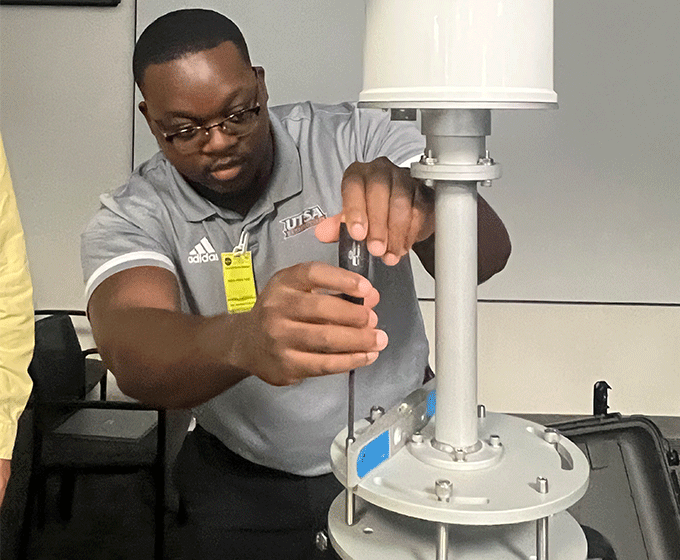
UTSA doctoral student Iyare Oseghae working on a Pandora spectrometer. The instrument measures columnar amounts of trace gases in the atmosphere. These gases absorb specific wavelengths of light from the sun in the ultraviolet-visible spectrum.
OCTOBER 12, 2023 — Atop the Durango Building on UTSA’s Downtown Campus will soon sit an instrument connecting UTSA to a global monitoring network of atmospheric pollution.
A five-year, $590,017 NASA grant is supporting the project, led by Alberto Mestas-Nuñez, associate professor of instruction in the UTSA Department of Earth and Planetary Sciences.
The project will make UTSA part of the NASA Pandora Project as well as a member of the Pandonia Global Network of stations, which is a joint effort between NASA and the European Space Agency to provide long-term measurements of air quality and atmospheric composition to calibrate satellite sensors.
UTSA is among 15 Minority Serving Institutions partnering with NASA to expand research opportunities in earth sciences.
“This is a great opportunity. There’s a lot to learn,” Mestas-Nuñez said. “To have this instrumentation in San Antonio at UTSA, collaborating on this global project, will surely help us attract new students to our education and research programs and potentially help us develop new programs.”
The Pandora Project uses spectroscopy to study ultraviolet and visible wavelengths of light to determine the composition of the atmosphere and its interactions with the Earth’s environment. The ground-based networks are unique with the ability to measure total column and vertical profiles, observing different layers of the atmosphere at once.
Mestas-Nuñez is working alongside fellow UTSA faculty members Daniel Pineda, assistant professor of mechanical engineering; Geography and Environmental Sustainability Assistant Professor Neil Debbage; and Mechanical Engineering Professor Kiran Bhaganagar. Also on the team are UTSA Environmental Science and Engineering doctoral student Iyare Oseghae and UT-Rio Grande Valley Professor Amit Raysoni.
UTSA researchers will be tasked with maintaining the device to ensure quality data is collected. The data will be transmitted to the central server of the Pandonia Global Network, where it will be processed and made available in real-time to the public. Levels of ozone, nitrogen dioxide and formaldehyde in the atmosphere will be studied by combining the observations measured by the network with those from Earth-observing satellites.
“We’ll use the data after the algorithms have been applied to convert the spectrometer sunlight measurements into gas concentrations—which is what we need,” Mestas-Nuñez said. “We will get a good handle on the pollution in the air and be able to study air quality and the processes associated with it. For example, we could study where the air pollution is coming from, where it is going, as well as what time of the day, day of the week, or month of the year the pollution is most prevalent.”
UTSA Today is produced by University Communications and Marketing, the official news source of The University of Texas at San Antonio. Send your feedback to news@utsa.edu. Keep up-to-date on UTSA news by visiting UTSA Today. Connect with UTSA online at Facebook, Twitter, Youtube and Instagram.
Move In To COLFA is strongly recommended for new students in COLFA. It gives you the chance to learn about the Student Success Center, campus resources and meet new friends!
Academic Classroom: Lecture Hall (MH 2.01.10,) McKinney Humanities BldgWe invite you to join us for Birds Up! Downtown, an exciting welcome back event designed to connect students with the different departments at the Downtown Campus. Students will have the opportunity to learn about some of the departments on campus, gain access to different resources, and collect some giveaways!
Bill Miller PlazaJoin us for an intimate evening of cocktails, conversation, and culinary inspiration with Pati Jinich, Emmy-nominated chef and James Beard Award-winning author. Enjoy light bites and signature drinks in the warm, modern setting of Mezquite as Pati connects with guests over her passion for Mexican cuisine and storytelling.
Mezquite Restaurant in Pullman Market, 221 Newell Ave., San Antonio 78215From inspired courses to thoughtful pairings and a rich sense of community, the Ven a Comer Signature Dinner is a night of shared meals, shared stories, and unforgettable flavor.
Stable Hall (Pear Brewery), 307 Pearl Pkwy, San Antonio 78215Come and celebrate this year's homecoming at the Downtown Campus with food, games, giveaways, music, and more. We look forward to seeing your Roadrunner Spirit!
Bill Miller PlazaThe University of Texas at San Antonio is dedicated to the advancement of knowledge through research and discovery, teaching and learning, community engagement and public service. As an institution of access and excellence, UTSA embraces multicultural traditions and serves as a center for intellectual and creative resources as well as a catalyst for socioeconomic development and the commercialization of intellectual property - for Texas, the nation and the world.
To be a premier public research university, providing access to educational excellence and preparing citizen leaders for the global environment.
We encourage an environment of dialogue and discovery, where integrity, excellence, respect, collaboration and innovation are fostered.